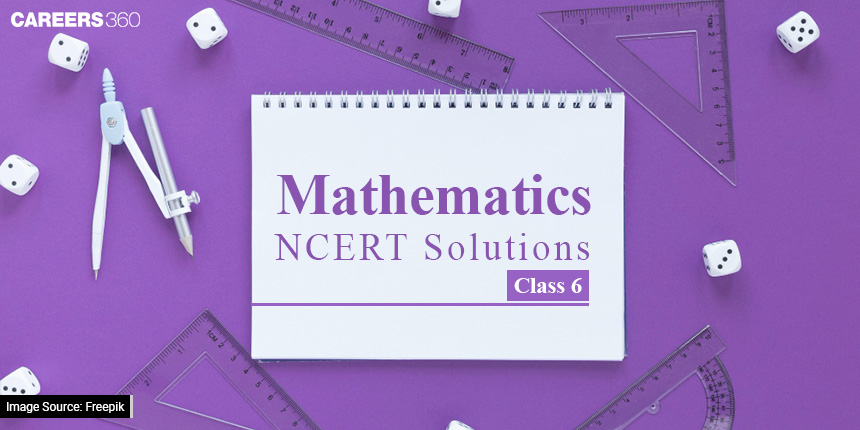Aakash Repeater Courses
ApplyTake Aakash iACST and get instant scholarship on coaching programs.
Mathematics plays a significant role in our day-to-day life. It teaches us about numbers, patterns, shapes, and more, helping students develop problem-solving, analytical, and logical skills. NCERT Class 6 Maths lays the foundation for higher-level mathematics by introducing students to patterns in mathematics, lines and angles, perimeter and area, data handling, fractions, and constructions, among other topics. These NCERT Solutions for Class 6 Maths help students to strengthen their basics by solving questions based on real-life examples.

The solutions provided here are clear and presented in a step-by-step manner, making them easy to understand. These solutions are reliable and accurate as they are created by the subject matter experts at Careers360. These articles, along with NCERT Solutions for Class 6, can be utilised by students for exam preparation, as they help to revise and face exam questions with confidence. Access all study materials, chapter summaries, and NCERT PDFs from this link.
Students can check out the NCERT Solutions for Class 6 Maths using the links below.
Patterns are a regular arrangement of shapes, objects or numbers in a certain rule. Most of the things around us follow a pattern. In this chapter, students will learn to identify patterns in things, shapes, or numbers and learn to form these patterns. This concept of patterns lays a foundation for the advanced mathematical topic of sequences.
The concept of lines and angles lays the foundation for geometry. Lines are straight figures with infinite length, and angles are formed when two rays meet at a common point. This chapter on lines and angles covers topics like types of lines, types of angles, and their respective properties.
This chapter on number play is a fun method to learn patterns and properties of numbers, like reversing digits, divisibility rules, using puzzles, and tricks.
A collection of information is called data. In this chapter, students will learn how to represent data and will work with data graphs like pictographs and bar graphs.
Prime time is a chapter about prime numbers. Prime numbers are a type of number that is divisible only by 1 and by itself. Students will be able to learn more about the prime numbers and their properties in this chapter.
Perimeter is the length of the boundary of a shape, and Area is the space enclosed within the boundary of the shape. In this chapter, students will learn to calculate the perimeter and the area of various shapes like rectangles, squares and triangles.
A fraction is a type of number that represents the part of something whole. This chapter covers various topics in fractions like addition, subtraction, multiplication and division of fractions, improper fractions, etc.
This chapter of Playing with Constructions covers topics construction of a line, an angle, and some shapes using tools like a ruler, a compass, and a protractor.
Symmetry is when a figure can be divided into identical halves. Symmetry gives beauty to many constructions and patterns. For example, the figure of the Taj Mahal is symmetrical (vertically), and rangoli with symmetry will look good. The chapter talks about the line of symmetry of figures.
This chapter on The Other Side of Zero is about the type of number called integers. Integers include negative numbers, zero, and positive numbers. This chapter covers topics like marking the integers on number lines and the addition and subtraction of integers.
Here are the steps to download the NCERT books in PDF.
Students can refer to the other resources, like the syllabus, books for Class 6, using the links below.
NCERT solutions are helpful for the students when they stuck while solving the problems. As these solutions are provided in a very simple language, so it can be understood by an average student also.
The NCERT Solutions for 6th class maths have been developed by the experts at Careers360 through extensive research on each concept. Students who have queries during class hours can download the solution PDFs from BYJU’S and learn the concepts effectively. These solutions are available in both chapter-wise and exercise-wise formats, which assist students in preparing for their exams with confidence.
Here, class 6 math solutions are provided. You can access these by clicking the link for NCERT solutions for class 6. These are prepared by the expert team at Careers360 keeping in mind the latest CBSE syllabus. Practice these to get an in-depth understanding and a good grasp on the concepts.
In the CBSE board exams, every problem, regardless of its level of difficulty, is crucial. Therefore, it is recommended that students solve the NCERT textbook problems daily to grasp the fundamental concepts. Regular practice enables students to identify their weaknesses and work on them to achieve better academic scores. The step-by-step explanations provided for each problem in the NCERT Solutions will aid students in performing well in their annual exams.

Take Aakash iACST and get instant scholarship on coaching programs.

This ebook serves as a valuable study guide for NEET 2025 exam.

This e-book offers NEET PYQ and serves as an indispensable NEET study material.

As per latest syllabus. Physics formulas, equations, & laws of class 11 & 12th chapters

As per latest syllabus. Chemistry formulas, equations, & laws of class 11 & 12th chapters
As per latest 2024 syllabus. Study 40% syllabus and score upto 100% marks in JEE
We endeavor to keep you informed and help you choose the right Career path. Sign in and access our resources on Exams, Study Material, Counseling, Colleges etc.